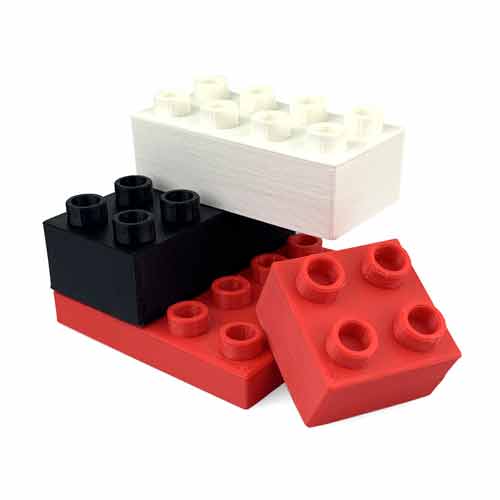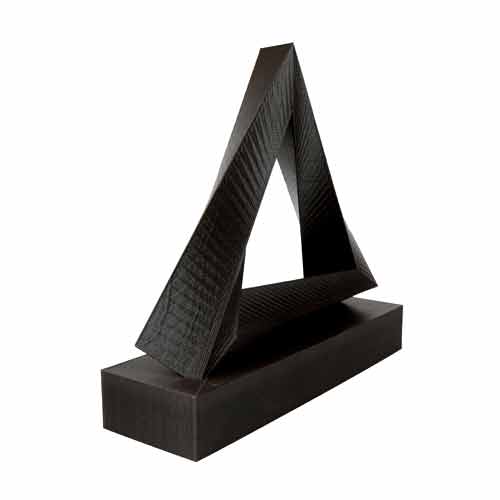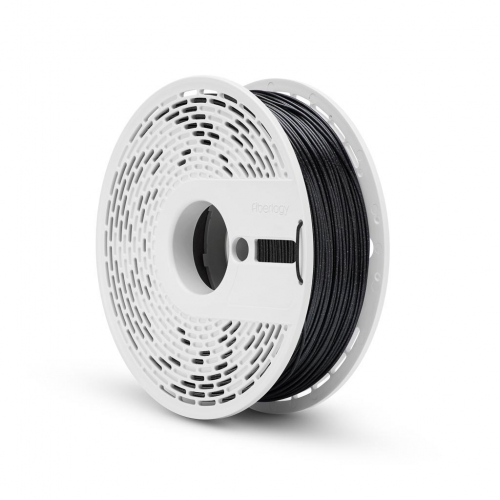
Fiberlogy ABS 1.75 mm Onyx 850 g
ABS-ONYX-175-085
Brand: Fiberlogy, Poland
Fiberlogy ABS is a high-strength filament known for its hardness, impact resistance, and resistance to high temperatures and abrasion. Ideal for creating functional prototypes and end-use parts.
- Strength: High | Stiffness: High
- Printing Difficulty: High (Requires experience and an enclosure)
- Printing Temperature: 250°C - 265°C
- Bed Temperature: 90°C - 110°C
- High Impact and Heat Resistance (HDT up to 94°C)
- Can be mechanically and chemically processed (acetone)
- NET Weight: 850 g
Fiberlogy ABS Filament Description for 3D Printers
3D4U presents ABS (Acrylonitrile Butadiene Styrene) from Fiberlogy – a true expert in strength and durability for FDM/FFF 3D printing. This 1.75 mm diameter, 850 g filament is a reliable choice for projects requiring high mechanical and thermal resistance.
Parts printed using Fiberlogy ABS are characterized by exceptional hardness, high impact resistance, and resistance to abrasion. They can also withstand elevated temperatures (up to 94°C), significantly expanding the application range compared to PLA or PETG.
The advantages of ABS are particularly valuable for engineers and designers. It allows for the creation of not only concept models and prototypes but also fully functional end-use parts, especially those requiring increased rigidity and resistance to external factors. The possibility of post-processing, both mechanical and chemical (e.g., acetone vapor smoothing), opens up additional opportunities for achieving a smooth surface finish.
Important: Printing ABS requires specific skills and conditions. Due to its tendency to shrink and emit fumes during printing, using a 3D printer with an enclosed chamber and good room ventilation is strongly recommended.

3D4U is the official distributor of the Polish brand Fiberlogy in Ukraine.
We offer a wide range of filament for 3D printers, provide professional consultations, and guarantee the authenticity of all Fiberlogy products.
Properties of Fiberlogy ABS Filament
Fiberlogy ABS possesses several key characteristics that make it a popular choice for engineering tasks:
- High Hardness and Stiffness: Ensures structural integrity of parts.
- High Impact Resistance: Prints are resistant to drops and impacts.
- Heat Resistance: Maintains shape at temperatures up to 94°C (HDT B).
- Abrasion Resistance: Suitable for parts subjected to friction.
- Post-Processing Capability: Easily sanded, drilled, and smoothed with acetone vapor for a glossy finish.
- Good Layer Adhesion (under proper conditions): Allows for the creation of strong, solid objects.
Printing Requirements: Successful ABS printing requires a heated build plate (90-110°C) and preferably an enclosed chamber to minimize shrinkage and prevent model delamination.
Examples of ABS Prints

Example print of construction brick-like parts from Fiberlogy ABS

Geometric shape demonstrating ABS printing capabilities
Applications of ABS
Thanks to its properties, Fiberlogy ABS finds application in various fields:
- Prototyping: Creating durable functional prototypes, connecting elements, enclosures, parts requiring heat resistance.
- Tooling and Jigs: Printing gauges, templates, fixtures, gears, and other parts needing high strength and wear resistance.
- Gadgets and Consumer Goods: Electronics housings, stands, keychains, protective cases.
- Toys: Construction brick elements (similar to LEGO), robot parts, car components.
- Household Items: Hangers, flower pots, vases, custom organizers.
It is a versatile engineering 3D printing material when increased strength and heat resistance are required.
Fiberlogy ABS Print Settings
The following parameters are recommended settings for Fiberlogy ABS. Achieving the best print quality may require fine-tuning the optimal values for your specific 3D printer and conditions.
| Parameter | Value |
|---|---|
| Nozzle Temperature | 250-265°C |
| Bed Temperature | 90-110°C |
| Enclosed Chamber | Recommended |
| Fan Speed | 0-10% (usually off) |
| Flow Rate | 95-105% |
| Printing Speed | 35-60 mm/s |
| Build Surface | Perforated plate, Kapton tape, glass + ABS juice, specialized ABS adhesives |
| Retraction (direct) | 2-3 mm |
| Retraction (bowden) | 4-6 mm |
| Retraction Speed | 20-45 mm/s |
| Drying Conditions | 60°C / 4h |
Note: Ensuring good first layer adhesion and minimizing warping requires a high and stable bed temperature (90-110°C). Using adhesives like ABS juice (ABS dissolved in acetone) or specialized glues, as well as printing with a brim or raft, is highly recommended. Printing in an enclosed chamber helps maintain a stable temperature around the model, significantly reducing the risk of delamination and shrinkage.
ABS Technical Specifications
| Parameter | Value | Test Method |
|---|---|---|
| Diameter | 1.75 mm | - |
| Diameter Tolerance | ± 0.02 mm | - |
| Average Roundness | + 0.01 mm | - |
| Net Weight | 850 g | - |
| Density | 1.04 g/cm³ | ISO 1183 |
| Tensile Strength @ Yield | 42 MPa | ISO 527 |
| Tensile Modulus | 1750 MPa | ISO 527 |
| Elongation @ Break | 35% | ISO 527 |
| Flexural Strength | 60 MPa | ISO 178 |
| Flexural Modulus | 1850 MPa | ISO 178 |
| Izod Impact Strength (Notched @ 23°C) | 30 kJ/m² | ISO 180 |
| Heat Distortion Temperature (HDT, 0.45 MPa) | 94°C | ISO 75 |
| Heat Distortion Temperature (HDT, 1.8 MPa) | 85°C | ISO 75 |
| Vicat Softening Temperature | 100°C | ISO 306 |
| Glass Transition Temperature (Tg) | 105°C | DSC |
Tips for 3D Printing with Fiberlogy ABS
Printing ABS can be challenging, but with the right approach, excellent results can be achieved:
- Use an Enclosed Chamber: This is the most crucial factor for successful ABS printing. An enclosure maintains a high and stable temperature around the model, preventing rapid shrinkage, delamination, and warping.
- Maximize Bed Adhesion: Heat the bed to 90-110°C. Use Kapton tape, ABS juice, or special adhesives. Printing with a wide brim or a raft also helps.
- Turn Off or Minimize Cooling Fan: Part cooling is generally unnecessary and even detrimental when printing ABS, as it causes too rapid cooling and shrinkage. Minimal cooling (up to 10%) might be acceptable only for bridges or steep overhangs.
- Ensure Room Ventilation: ABS emits fumes with a distinct odor (styrene) when printed. Print in a well-ventilated area or use an air filtration system.
- Dry the Filament: ABS also absorbs moisture, although less than PETG or Nylon. Drying at 60°C for 4 hours will improve print quality and layer adhesion.
- Avoid Drafts: Even with an enclosure, sudden temperature changes from drafts can negatively impact the print.
ABS Juice Tip: To make ABS juice, dissolve small pieces of ABS filament scraps in acetone until you get a consistency like thin glue. Apply a thin layer to a cold glass bed before heating.
Comparing ABS with Other Fiberlogy Materials
Choosing between ABS and other plastics depends on the requirements for the final part:
| Material | Key Advantages | Key Disadvantages | When to Choose ABS |
|---|---|---|---|
| Fiberlogy ABS | High strength, impact resistance, heat resistance (up to ~90-100°C), processability (mechanical, chemical) | Difficult to print (shrinkage, odor, needs enclosure), low UV resistance | For functional parts, enclosures, prototypes requiring strength, heat resistance, and post-processing options |
| Fiberlogy Easy PLA | Easy to print, good detail, biodegradable | Low heat resistance (~50-60°C), brittle | For decorative models, prototypes without high loads, when ease of printing is key |
| Fiberlogy Easy PET-G | Stronger than PLA, good chemical resistance, low shrinkage, easier to print than ABS | Moderate heat resistance (~70°C), prone to stringing | For functional parts where PLA isn't strong enough, and ABS's heat resistance is overkill |
| Fiberlogy ASA | Similar properties to ABS (strength, heat resistance), but with high UV resistance | Difficult to print (like ABS), more expensive | Similar to ABS, but for parts used outdoors under sunlight |
ABS remains a popular engineering plastic due to its combination of strength, heat resistance, and post-processing capabilities, despite its higher printing demands.
Why Choose Fiberlogy ABS
Fiberlogy ABS is an excellent choice for those seeking a reliable and high-performance material:
- Mechanical Strength: Ideal for creating parts subjected to loads and impacts.
- Heat Resistance: Withstands higher temperatures than PLA and PETG, crucial for many functional applications.
- Post-Processing Options: Easily sanded, drilled, painted, and acetone-smoothed for a professional finish.
- Durability: Abrasion resistance ensures a long service life for printed parts.
- Fiberlogy Quality: Consistent diameter and material homogeneity guarantee predictable printing results.
- Reliability from 3D4U: Buying from the official distributor in Ukraine ensures you receive an authentic product and qualified support.
If you need a strong and heat-resistant material for serious projects, Fiberlogy ABS is a proven solution.
How to Order Fiberlogy ABS
Ordering Fiberlogy ABS filament in Ukraine is easy through the 3D4U online store:
- Select the desired color and diameter (1.75 mm).
- Add the product to your cart.
- Proceed to checkout, providing your contact details and delivery address.
- Choose your preferred payment and delivery method.
- Confirm your order.
If you have questions about ABS properties, print settings, or the ordering process, our consultants are always ready to provide the necessary information and assistance.
Create strong and functional parts with Fiberlogy ABS from 3D4U!
FAQ (Frequently Asked Questions) about Fiberlogy ABS
ABS (Acrylonitrile Butadiene Styrene) is a thermoplastic polymer widely known for its strength, rigidity, impact resistance, and good heat resistance. In 3D printing, it's used to create functional prototypes, device enclosures, mechanical parts, toys (like LEGO bricks), and other items where mechanical properties and durability are important.
It is highly recommended. ABS undergoes significant thermal shrinkage upon cooling. Printing without an enclosure leads to uneven cooling of the model, causing internal stresses, warping (especially corner lifting from the bed), and layer separation. An enclosure maintains a consistently high ambient temperature around the part, minimizing these issues and improving layer adhesion. Theoretically, small parts might be printed without an enclosure in a warm, draft-free room, but for quality and large prints, an enclosure is practically necessary.
Warping is the main challenge when printing ABS. To combat it:
- Use an enclosed chamber: Maintains stable temperature.
- High bed temperature: 90-110°C keeps the bottom layers warm and less prone to shrinking.
- Good first layer adhesion: Use ABS juice, Kapton tape, or special adhesives. Ensure the bed is clean and properly leveled.
- Print with a brim or raft: A brim increases the first layer's contact area with the bed; a raft creates a base under the model.
- Turn off the cooling fan: Cooling accelerates cooling and shrinkage.
- Avoid drafts: Print in an area free from sudden air currents.
Yes, this is one of the advantages of ABS. The surface can be smoothed mechanically (sanding, polishing) or chemically. The most popular chemical method is acetone vapor smoothing ("acetone bath"). Acetone vapor dissolves the top layer of the plastic, smoothing out layer lines and giving the part a glossy finish. It's important to perform this procedure carefully, in a well-ventilated area, and away from ignition sources, as acetone is flammable and its vapors are harmful to inhale.
No, standard ABS is not considered safe for food contact. It may contain residual monomers and other additives that can migrate into food. Additionally, the porous nature of 3D printed objects encourages bacterial growth. For food-contact items, specially certified materials (certain types of PETG, PP, or special PLAs) should be used.
When heated, ABS releases styrene vapors, which have a characteristic smell often described as "burning plastic". These fumes can be unpleasant and potentially harmful if inhaled in high concentrations over long periods. Therefore, it is strongly recommended to print ABS in a well-ventilated area. Using a 3D printer with an enclosed chamber and an air filtration system (like an activated carbon filter) also helps reduce the spread of odor and particles.
Yes, printing Fiberlogy ABS on Bambu Lab printers (especially the enclosed models like X1 series and P1 series) is possible and often yields good results. It is recommended to:
- Use the "Generic ABS" profile or create a custom one based on it.
- Set the nozzle temperature to 250-265°C.
- Set the bed temperature to 100-110°C.
- Always use an adhesive (Bambu glue stick or similar) on the build plate (High Temperature Plate or Engineering Plate).
- Ensure the printer's chamber is closed during printing.
- Turn off or significantly reduce the part cooling fan speed, typically to 0-10%. The chamber fan should run to exhaust fumes through the filter.
- Pre-dry the filament.
The A1/A1 Mini models do not have an enclosure and are not designed for printing ABS.
| Manufacturer | Fiberlogy |
|---|---|
| Printing technology | FDM/FFF |
| Material type | ABS |
| Printing temperature, ℃ | 250-265 |
| Platform temperature, ℃ | 90-110 |
| Filament diameter, mm | 1.75 |
| Allowable deviation, mm | ±0.02 |
| Density, kg/m³ | 1.04 |
| Color | Dark gray Gray |
| Surface Finish / Effect | Glitter / Sparkle (Galaxy) |
| Filler / Additives | Glitter |
| Heat Resistance | High (85-110°C) |
| Special Properties | Impact Resistant Rigid |
| Spool Format | Standard Spool |
| Length, m | 340 |
| Weight, kg | 0.850 |
| Country | Poland |
| Condition | New |
No reviews for the product









